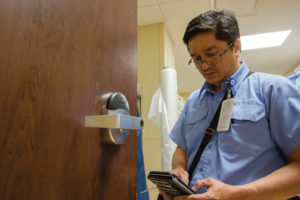Nebraska Methodist Health System
by Juliette B. Bradley
The Nebraska Methodist Health System (NMHS) includes three hospitals (Methodist Hospital, Methodist Women’s Hospital and Women’s Center and, Methodist Jennie Edmundson Hospital), 21 clinic locations, a nursing and allied health college, medical supply distributorship, and a central laundry.
NMHS is committed to providing high quality care. In order to continue that mission, several building expansion and renovation projects have been on-going — some are complete, and new projects are just beginning.
The Methodist Women’s Hospital Neonatal Intensive Care Unit (NICU) completed an expansion in 2017, now offering 51 private beds and also a private family lounge for parents to relax and rest during their baby’s stay. Private rooms for NICU babies are essential to their growth and development, as each room can be controlled to the baby’s needs. Research shows that the smallest NICU babies do the best when they are in private rooms.
The 14,000 sq. ft. expansion includes 13 single rooms and five rooms for multiples. In the past, Methodist Women’s Hospital on occasion had to transfer babies to other facilities for their care because of available space. Now, because of the expansion, that will not be an issue any longer.
Methodist Hospital, the regional leader in surgeries, recently unveiled 15 new surgical suites in 2016, bringing a $90 million surgery renovation and expansion project to a close. The Phase II project is a massive 60,551 sq. ft. and encompasses the new sterile processing department on the lower level, the first floor surgical suites and surgery waiting area, and the second floor staff lounges and surgical department office.
Scheduling the construction/expansion in phases was key to allowing surgical services to continue during the entire construction process. Phase IIIA and Phase IIIB, which upon completion will result in 44 new private prep/recovery rooms, began in 2016 and is anticipated to take 18 to 24 months.
An enterprise like NMHS is focused on keeping staff, patients and visitors safe and it uses a range of security measures to do this. A critical safety measure for NMHS is access control at the door opening. NMHS’s Director of Public Safety, Matt Shaw, learned that the 8/28 integration that American Direct and AccessNsite provides could benefit the healthcare setting and he chose to use the design/build approach to accomplish this.
“Many of our spaces where we want access control are open access environments and historically have been difficult to secure because of free-flow traffic,” Shaw said. “Some traditional ways to secure access can be defeated or are very expensive. Now, we have one point of reference (American Direct/AccessNsite) to go to in order to determine a plan for every opening and discuss issues such as door and hardware selection, intrusion devices, lockset asthetics, and re-keying needs.”

American Direct and AccessNsite work with the architect, the general contractor, and the owner early on to make sure the client is going to end up with the complete solution. AccessNsite’s Project Manager, Heather Rolli, says, “All parties involved are asked to participate in one forum so there are no missing links. Traditionally, the end user can get left out, but because of the way we do business, the end user is part of the early consultation and there are no surprises later.”
In a healthcare environment, every department has a different level of safety that American Direct and AccessNsite mutually address. For example, there are completely different safety issues when addressing behavioral health (using anti-ligature locks to prevent patient self-harm), and NICU, where infant abduction lockdown systems would be important. Rolli emphasizes how crucial open communication is with all parties involved before construction begins so that all of the needs and expectations can be met.
Enterprises like NMHS have many contractors, subcontractors, visitors, and employees — all of which, from an access standpoint, can be managed via AccessNsite. AccessNsite’s Vice President, Enterprise Systems, Brian Ashley, says “AccessNsite is fully integrated into NMHS’s human resources (HR) solution. Whenever NMHS adds new employee information into their HR system, that data is automatically ported into AccessNsite and AccessNsite then manages which doors those individuals can access depending on their job title.
One of the highly regarded features of AccessNsite is that it is powerful, flexible, and configurable to the client’s needs. NMHS is currently utilizing AccessNsite to do the following:
- Monitor intrusion — forced door alarms
- Single sign-on for computers — using your credential badge at the printer so you receive only your documents and private information doesn’t end up in anyone else’s hands
- NOW Vitals — NMHS’s system that uses the AccessNsite’s credential as a way to validate employee status to upload patient vitals into the medical record
Access control choices for NMHS include bluetooth locks. Shaw says, “Bluetooth is a good alternative because we are not pulling cables, which means we decrease necessary labor and amounts of equipment. Basically it is costing us 60 percent less per door. This is an energized lockset that works in conjunction with a credential to gain access, so instead of pulling 120 volts and pulling cables to energize the strike in the door, we simply replace the door handle and battery operated lock.”
The synergy between American Direct, AccessNsite and NMHS is impressive. Ashley says, “NMHS is never making a move without contacting us — that way they will get an immediate response. We are responsive to their needs and we are truly a team. We are more than a vendor to them, and they are more than a client to us.”
“Going in, we expect to pay a certain amount of money for security, but then American Direct helps us bring that cost down — they help us get more security for our money,” Shaw said.




